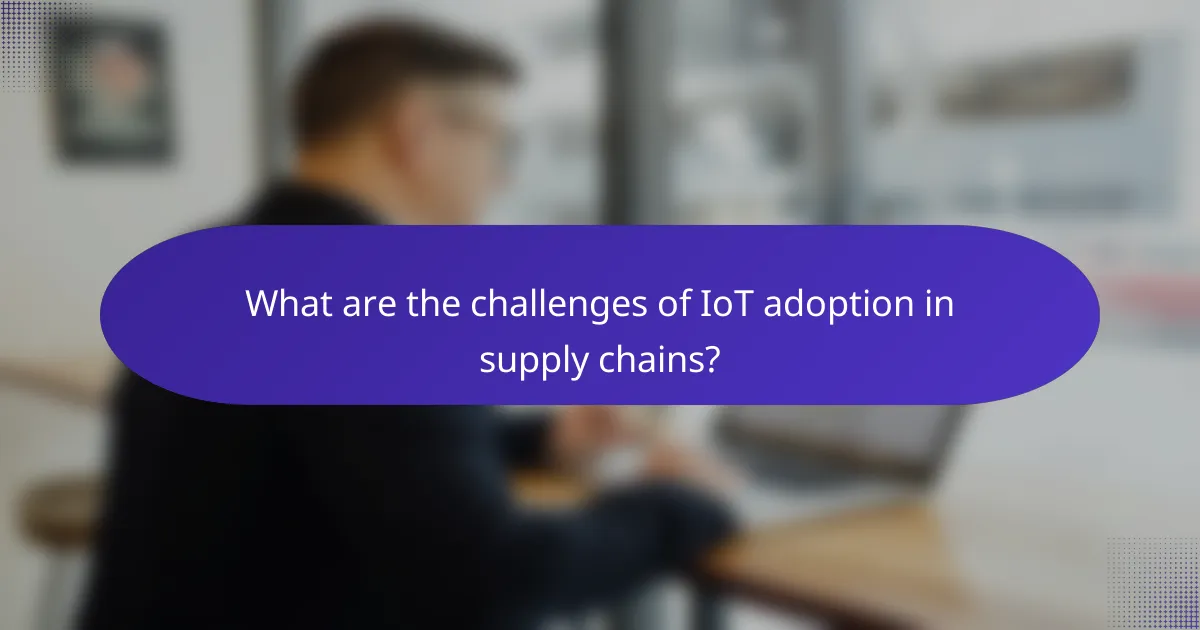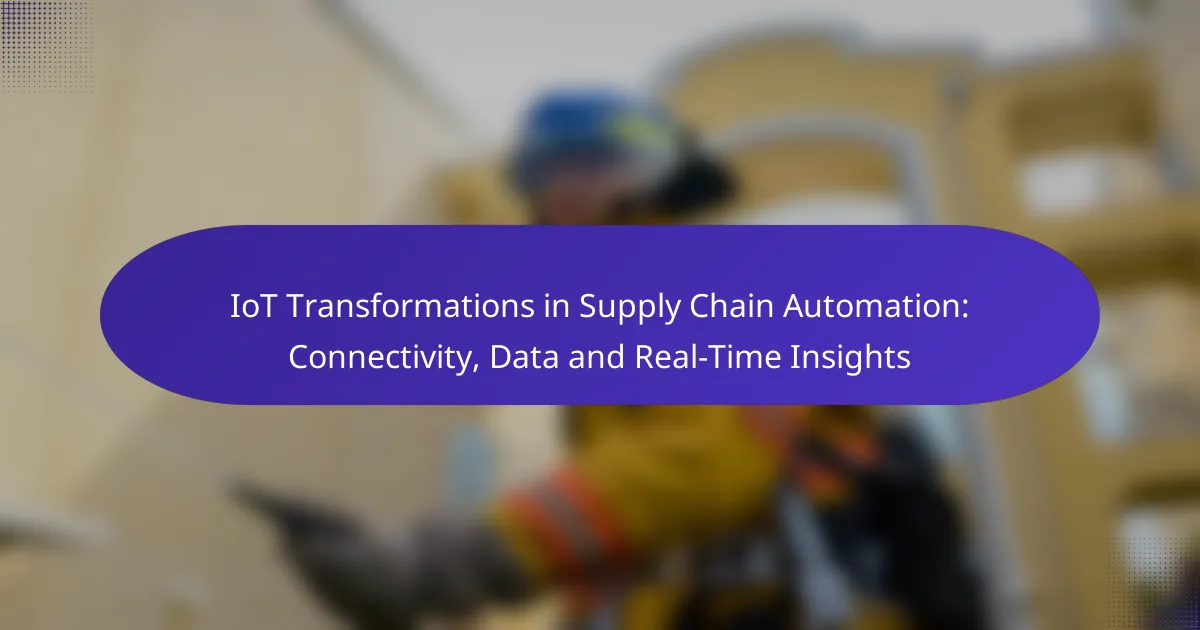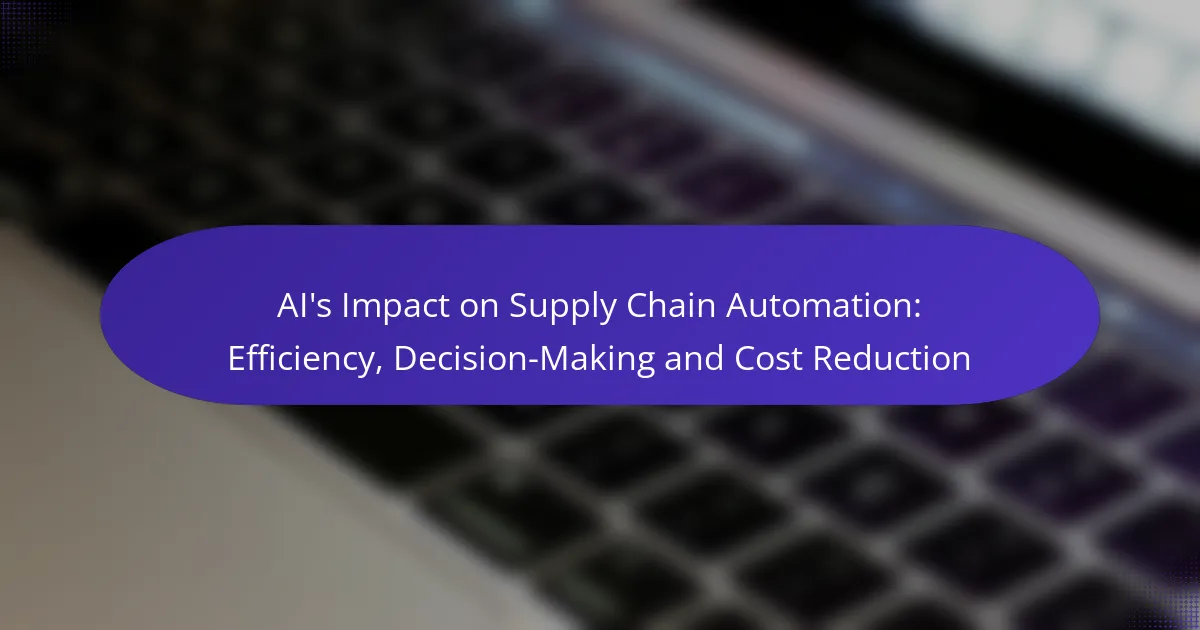The Internet of Things (IoT) is transforming supply chain automation by significantly enhancing connectivity and enabling real-time data analytics. This technological shift empowers businesses to make informed decisions, optimize inventory management, and ultimately reduce operational costs, leading to greater efficiency and visibility across the supply chain.

How is IoT transforming supply chain automation?
IoT is revolutionizing supply chain automation by enhancing connectivity, enabling real-time data analytics, and improving overall efficiency. These advancements allow businesses to make informed decisions, optimize inventory, and reduce operational costs.
Enhanced connectivity through IoT devices
IoT devices facilitate seamless communication across the supply chain by connecting machinery, vehicles, and inventory systems. This connectivity enables stakeholders to monitor processes in real-time, leading to quicker responses to disruptions.
For example, sensors on delivery trucks can provide live updates on location and temperature, ensuring that perishable goods are transported under optimal conditions. This level of connectivity helps in maintaining product quality and reducing waste.
Real-time data analytics for decision-making
Real-time data analytics powered by IoT devices allows companies to analyze vast amounts of information instantly. This capability supports timely decision-making, helping businesses to respond to market changes and customer demands effectively.
By leveraging analytics, companies can identify trends, forecast demand, and optimize routes, which can lead to significant cost savings. For instance, a logistics firm might use data to adjust delivery schedules based on traffic patterns, improving efficiency.
Improved inventory management
IoT technology enhances inventory management by providing accurate, real-time visibility into stock levels. This visibility helps businesses avoid overstocking or stockouts, leading to better cash flow management.
Using RFID tags and smart shelves, companies can track inventory movements automatically, reducing manual errors and labor costs. This system allows for more precise reordering processes, ensuring that products are available when needed without excessive surplus.
Predictive maintenance capabilities
Predictive maintenance, enabled by IoT sensors, allows companies to anticipate equipment failures before they occur. By analyzing data from machinery, businesses can schedule maintenance proactively, minimizing downtime and repair costs.
For example, a manufacturing plant can use vibration sensors to monitor machinery health, predicting when a part may fail. This approach not only extends the lifespan of equipment but also enhances overall operational efficiency.

What are the key benefits of IoT in supply chains?
The Internet of Things (IoT) offers significant advantages in supply chain management by enhancing connectivity, enabling data-driven decisions, and providing real-time insights. These benefits lead to improved efficiency, reduced costs, and greater visibility throughout the supply chain.
Increased operational efficiency
IoT devices streamline operations by automating routine tasks and providing real-time data on inventory levels, equipment status, and transportation conditions. This automation minimizes manual intervention, allowing staff to focus on more strategic activities.
For example, smart sensors can monitor machinery performance, alerting operators to potential failures before they occur. This proactive approach reduces downtime and enhances overall productivity.
Cost reduction through automation
By implementing IoT solutions, companies can significantly lower operational costs. Automation reduces labor costs and minimizes errors associated with manual processes, leading to more accurate inventory management and order fulfillment.
Additionally, IoT can optimize logistics by analyzing shipping routes and delivery schedules, which can lead to savings on fuel and transportation expenses. Companies often see cost reductions in the range of 10-30% after adopting these technologies.
Enhanced visibility across the supply chain
IoT technology provides comprehensive visibility into the supply chain by enabling real-time tracking of goods from production to delivery. This transparency helps businesses respond quickly to disruptions and make informed decisions based on current data.
With IoT, stakeholders can access dashboards that display key metrics, such as shipment status and inventory levels, allowing for better coordination among suppliers, manufacturers, and retailers. This visibility is crucial for maintaining customer satisfaction and meeting delivery commitments.

How can businesses implement IoT solutions?
Businesses can implement IoT solutions by strategically assessing their current infrastructure, selecting suitable IoT platforms, and integrating these technologies with existing systems. This approach ensures a seamless transition to automated processes that enhance efficiency and data-driven decision-making.
Assessing current infrastructure
To implement IoT solutions effectively, businesses must first evaluate their existing infrastructure. This includes examining current hardware, software, and network capabilities to identify gaps that IoT technologies can fill. A thorough assessment helps in understanding the necessary upgrades or replacements needed for successful integration.
Consider conducting a SWOT analysis (Strengths, Weaknesses, Opportunities, Threats) to pinpoint areas where IoT can add value. For example, if a company relies on outdated sensors, upgrading to smart sensors can improve data accuracy and operational efficiency.
Selecting appropriate IoT platforms
Choosing the right IoT platform is crucial for successful implementation. Businesses should look for platforms that offer scalability, security, and compatibility with existing systems. Popular platforms include AWS IoT, Microsoft Azure IoT, and Google Cloud IoT, each providing unique features tailored to different business needs.
When selecting a platform, consider factors such as ease of use, support services, and integration capabilities. A platform that supports industry standards can facilitate smoother connections between devices and applications, enhancing overall functionality.
Integrating IoT with existing systems
Integrating IoT solutions with existing systems requires careful planning and execution. Start by mapping out how new IoT devices will interact with current software and hardware. This may involve APIs or middleware to ensure seamless communication between systems.
It’s essential to prioritize data security during integration. Implementing robust security protocols, such as encryption and access controls, can protect sensitive information from potential breaches. Regularly updating systems and conducting security audits can further mitigate risks associated with IoT integration.

What are the challenges of IoT adoption in supply chains?
IoT adoption in supply chains faces several significant challenges, including data security and privacy concerns, high initial investment costs, and a lack of skilled workforce. Addressing these issues is crucial for successful implementation and maximizing the benefits of IoT technologies.
Data security and privacy concerns
Data security and privacy are paramount when integrating IoT devices into supply chains. These devices collect vast amounts of sensitive information, making them attractive targets for cyberattacks. Companies must implement robust security measures, such as encryption and secure access controls, to protect data integrity.
Additionally, compliance with regulations like GDPR in Europe or CCPA in California is essential. Organizations should conduct regular audits and risk assessments to identify vulnerabilities and ensure that data handling practices meet legal standards.
High initial investment costs
The initial investment costs for IoT technology can be substantial, often deterring companies from adoption. Expenses include purchasing devices, infrastructure upgrades, and software solutions. Businesses should carefully evaluate the return on investment (ROI) by considering potential efficiency gains and cost savings over time.
To mitigate costs, companies can explore phased implementation strategies, starting with pilot projects that demonstrate value before scaling up. This approach allows for better budget management and reduces financial risk.
Lack of skilled workforce
A significant barrier to IoT adoption in supply chains is the shortage of skilled professionals who can manage and analyze IoT data. This gap can hinder the effective deployment and maintenance of IoT systems. Companies may need to invest in training programs or collaborate with educational institutions to develop a talent pipeline.
Furthermore, partnering with IoT solution providers can offer access to expertise and resources that may not be available in-house. This collaboration can help bridge the skills gap and accelerate the adoption process.

What role do data and analytics play in IoT supply chains?
Data and analytics are crucial in IoT supply chains as they enable organizations to gain insights, optimize operations, and enhance decision-making. By leveraging real-time data, companies can improve efficiency, reduce costs, and respond quickly to market changes.
Real-time performance monitoring
Real-time performance monitoring involves continuously tracking key metrics such as inventory levels, shipment statuses, and equipment efficiency. This allows businesses to identify issues as they arise, minimizing delays and disruptions in the supply chain.
For effective monitoring, companies should implement IoT sensors and dashboards that provide instant visibility into operations. Regularly reviewing these metrics helps in adjusting strategies promptly, ensuring optimal performance.
Data-driven decision-making
Data-driven decision-making relies on analyzing collected data to inform strategic choices. By utilizing analytics tools, organizations can uncover trends and patterns that guide inventory management, supplier selection, and logistics planning.
To enhance decision-making, companies should focus on integrating data from various sources, such as sales forecasts and market analysis. This holistic view enables more informed choices, reducing risks associated with supply chain uncertainties.
Predictive analytics for demand forecasting
Predictive analytics uses historical data and statistical algorithms to forecast future demand. This approach helps businesses anticipate customer needs, allowing for better inventory management and resource allocation.
Implementing predictive analytics involves collecting relevant data, such as sales trends and seasonal fluctuations. Companies should regularly refine their models to improve accuracy and adapt to changing market conditions, ensuring they meet customer demand without overstocking.

How does IoT improve supply chain visibility in North America?
IoT enhances supply chain visibility in North America by providing real-time data and connectivity across various stages of the supply chain. This technology enables businesses to track inventory, monitor shipments, and gain insights into operational efficiency, leading to improved decision-making and responsiveness.
Real-Time Tracking of Assets
IoT devices, such as RFID tags and GPS sensors, facilitate the real-time tracking of assets throughout the supply chain. Companies can monitor the location and condition of goods as they move from suppliers to warehouses and ultimately to customers. This visibility helps in reducing delays and optimizing routes.
For instance, a logistics company can use IoT-enabled sensors to track temperature-sensitive products, ensuring they remain within required temperature ranges during transit. This proactive monitoring can prevent spoilage and reduce waste, ultimately saving costs.
Data-Driven Decision Making
With IoT, businesses can collect vast amounts of data from various sources, enabling data-driven decision-making. This data includes inventory levels, shipment statuses, and customer demand patterns, which can be analyzed to forecast needs and streamline operations.
Companies can implement predictive analytics to anticipate supply chain disruptions and adjust their strategies accordingly. For example, if data indicates a potential delay in shipping, a business can proactively reroute shipments or adjust inventory levels to mitigate impact.
Improved Collaboration and Communication
IoT fosters better collaboration and communication among supply chain partners. By sharing real-time data, stakeholders can work together more effectively, leading to enhanced coordination and reduced misunderstandings.
For example, suppliers and retailers can access the same data regarding inventory levels and shipment statuses, allowing them to synchronize their operations. This transparency can lead to improved relationships and more efficient supply chain processes.



